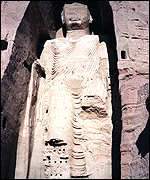UNESCO envoy leads rescue of endangered Afghan
Assets
The Kyodo New
 TOKYO -- Following the shock of what it called a ''crime against
culture'' - Afghanistan's destruction of two giant Buddha statues in March - UNESCO is
trying to devise ways to rescue the country's surviving cultural properties. Spearheading
these efforts is Ikuo Hirayama, 71, a well-known Japanese painter and goodwill envoy of
the U.N. Educational, Scientific and Cultural Organization, whose ''cultural property red
cross'' activities to preserve cultural sites resulted in his winning this year's Ramon
Magsaysay Award, Asia's version of the Nobel Prize.
TOKYO -- Following the shock of what it called a ''crime against
culture'' - Afghanistan's destruction of two giant Buddha statues in March - UNESCO is
trying to devise ways to rescue the country's surviving cultural properties. Spearheading
these efforts is Ikuo Hirayama, 71, a well-known Japanese painter and goodwill envoy of
the U.N. Educational, Scientific and Cultural Organization, whose ''cultural property red
cross'' activities to preserve cultural sites resulted in his winning this year's Ramon
Magsaysay Award, Asia's version of the Nobel Prize.
Invested with complete
authority on this issue by the U.N. agency, Hirayama is calling for a system to
temporarily house in Japan Afghan cultural properties which have been taken out of the
country due to internal strife and to treat them as if they were ''refugees'' facing the
threat of death upon returning.
''It was the first case
in which a country destroyed its own cultural properties and all UNESCO could do was to
express regret. I am proposing a system in which UNESCO is empowered to protect such
assets on behalf of the country, which has become incapable of doing so,'' Hirayama told
curators and cultural officials earlier this week.
In March, Afghanistan's
Taliban authorities demolished two towering, cliff-hewn Buddha statues in Bamyan,
northwest of Kabul, following an edict by its leader Mullah Mohammad Omar which labeled
them as offensive to Islam.
The statues, 55 meters
and 38 meters in height, dated from the fifth century, before the region fell under the
influence of Islam.
Even before the issuance
of the edict, conflicts in Afghanistan had put the country's artifacts at great risk.
Since the 1993 bombing of the Afghan National Museum in Kabul, many treasures have been
taken out of the country illegally and have changed hands in world art markets.
The safeguard measures
contemplated by UNESCO involve establishing a committee for provisional preservation of
Afghan cultural assets in exile, consisting of representatives of museums, foundations and
other experts. A full mandate will be given to the body by the U.N. agency to carry out
its task, Hirayama said.
According to the painter,
several dozen Afghan artifacts have been smuggled to Japan via a third country and kept by
wealthy collectors in the country.
Among such artifacts is
''Zeus' Foot'' -- a Greek stone figure dating back to the third century B.C., which was
unearthed in the ruins of Ai Khanum in northeastern Afghanistan in the 1960s and was owned
by the Kabul museum.
The 28-centimeter-long,
21-cm-wide marble figure featuring patterns of a sandal is a part of the left foot of a
3-meter-high seated image of Zeus. It went missing from the museum during armed conflicts
and ended up being donated to UNESCO.
An antique art dealer in
Tokyo obtained the property on condition it be returned to Afghanistan when peace is
restored there but later donated it to the U.N. body. The foot is now provisionally being
kept by Hirayama.
Procedures are also under
way to transfer to UNESCO seven pieces of Bamyan stone cave paintings that were taken out
of Afghanistan two to three years ago and acquired by the art dealer, the envoy said.
The mural paintings of
Buddha from around the fifth century were possibly taken by looters from caves near from
the cliffs where the destroyed statues were situated, Hirayama said.
One of the seven, a 33-
by 29-centimeter image of Buddha wearing a red robe, had its face hollowed out. It was
spotted by archeologists of Kyoto University during their cave explorations in the 1970s,
according to the goodwill envoy.
Hirayama said he has also
been negotiating with Japanese holders of several dozen other Afghan properties such as a
2-meter stone Buddhist image formerly kept at the Kabul museum, as well as ivory ornaments
and medallions, so that they could be taken into UNESCO's custody.
The painter hopes
Japanese museums will shelter and display these Afghan treasures. He has asked curators of
the Tokyo National Museum to examine the Afghan artifacts he is keeping.
Because purchase of
illegally traded properties is banned under the 1970 UNESCO Convention on the Means of
Prohibiting and Preventing the Illicit Import, Export and Transfer of Ownership of
Cultural Property, Hirayama is urging holders of such artifacts to voluntarily submit
them.
He cannot take strong
measures because Japan has not ratified the 1970 convention, which also obliges parties to
return stolen cultural properties to nations of their origin. Under the planned scheme,
UNESCO will temporarily take care of such artifacts and return them to Afghanistan if it
becomes capable of preserving them.
To facilitate transfers,
UNESCO is ready to pay for necessary expenses for preservation and transportation of the
items with a $75,000 fund, collected during the March Afghan cultural crisis.
Hirayama, who has been
engaged in cultural heritage preservation efforts in such countries as China, North Korea
and Cambodia, said Japan should take the lead in safeguarding Asian cultural properties.
''Only Japan can carry
out such task because it has close spiritual and cultural ties with Asian countries.
Western countries cannot do that job,'' he said.
He also stressed
the importance of protecting cultural assets regardless of political ideologies as a way
of helping to create peace in the future.